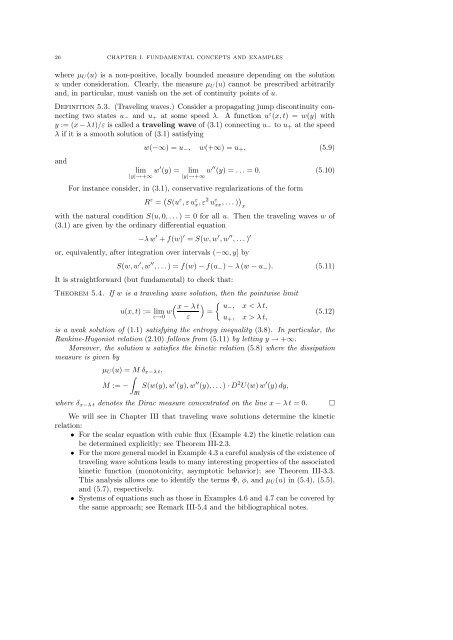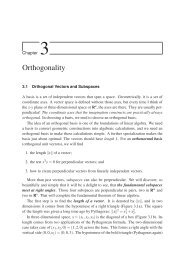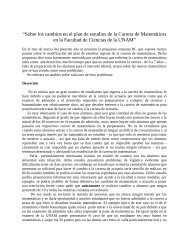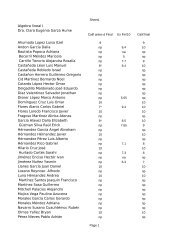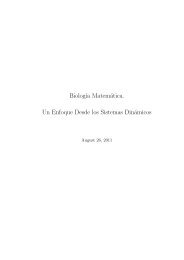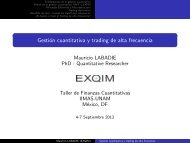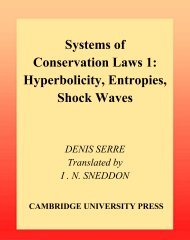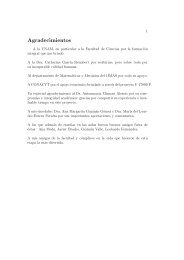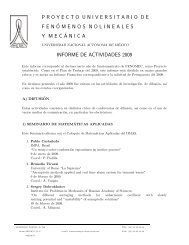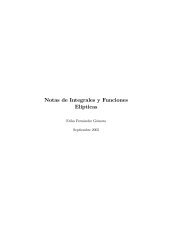Order Form - FENOMEC
Order Form - FENOMEC
Order Form - FENOMEC
Create successful ePaper yourself
Turn your PDF publications into a flip-book with our unique Google optimized e-Paper software.
26 CHAPTER I. FUNDAMENTAL CONCEPTS AND EXAMPLES<br />
where µ U (u) is a non-positive, locally bounded measure depending on the solution<br />
u under consideration. Clearly, the measure µ U (u) cannot be prescribed arbitrarily<br />
and, in particular, must vanish on the set of continuity points of u.<br />
Definition 5.3. (Traveling waves.) Consider a propagating jump discontinuity connecting<br />
two states u − and u + at some speed λ. A function u ε (x, t) =w(y) with<br />
y := (x − λt)/ε is called a traveling wave of (3.1) connecting u − to u + at the speed<br />
λ if it is a smooth solution of (3.1) satisfying<br />
w(−∞) =u − , w(+∞) =u + , (5.9)<br />
and<br />
lim<br />
|y|→+∞ w′ (y) = lim<br />
|y|→+∞ w′′ (y) =...=0. (5.10)<br />
For instance consider, in (3.1), conservative regularizations of the form<br />
R ε = ( S(u ε ,εu ε x,ε 2 u ε xx,...) ) x<br />
with the natural condition S(u, 0,...) = 0 for all u. Then the traveling waves w of<br />
(3.1) are given by the ordinary differential equation<br />
−λw ′ + f(w) ′ = S(w, w ′ ,w ′′ ,...) ′<br />
or, equivalently, after integration over intervals (−∞,y]by<br />
S(w, w ′ ,w ′′ ,...)=f(w) − f(u − ) − λ (w − u − ). (5.11)<br />
It is straightforward (but fundamental) to check that:<br />
Theorem 5.4. If w is a traveling wave solution, then the pointwise limit<br />
( x − λt<br />
) {<br />
u− , x < λt,<br />
u(x, t) := lim w =<br />
(5.12)<br />
ε→0 ε u + , x > λt,<br />
is a weak solution of (1.1) satisfying the entropy inequality (3.8). In particular, the<br />
Rankine-Hugoniot relation (2.10) follows from (5.11) by letting y → +∞.<br />
Moreover, the solution u satisfies the kinetic relation (5.8) where the dissipation<br />
measure is given by<br />
µ U (u) =Mδ x−λt ,<br />
∫<br />
M := − S(w(y),w ′ (y),w ′′ (y),...) · D 2 U(w) w ′ (y) dy,<br />
IR<br />
where δ x−λt denotes the Dirac measure concentrated on the line x − λt=0.<br />
We will see in Chapter III that traveling wave solutions determine the kinetic<br />
relation:<br />
• For the scalar equation with cubic flux (Example 4.2) the kinetic relation can<br />
be determined explicitly; see Theorem III-2.3.<br />
• For the more general model in Example 4.3 a careful analysis of the existence of<br />
traveling wave solutions leads to many interesting properties of the associated<br />
kinetic function (monotonicity, asymptotic behavior); see Theorem III-3.3.<br />
This analysis allows one to identify the terms Φ, φ, andµ U (u) in (5.4), (5.5),<br />
and (5.7), respectively.<br />
• Systems of equations such as those in Examples 4.6 and 4.7 can be covered by<br />
the same approach; see Remark III-5.4 and the bibliographical notes.<br />
□


